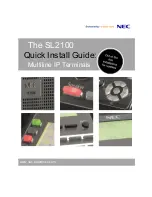
Troubleshooting
363-753-142-01, Revision 01
8
July 23, 1999
FRC-753 List 4B
C
USTOMER
R
EPORTED
P
ROBLEMS
Table 2
provides troubleshooting procedures based on customer reported problems.
Table 2.
FRC-753 RT Channel Unit Troubleshooting
Problem
Cause
Action
No dial tone,
can not dial
•
faulty RT or COT Channel
Unit
•
facility short/open
•
CO switch problem
1
Lift the subscriber pair at the network interface. If dial tone is present and you
can place a call, refer the problem to the customer per local practice.
2
If you cannot hear dial tone or cannot place a call at the network interface (with
the subscriber pair lifted), check for dial tone at the RT. If dial tone is present,
check the pair between the RT and the network interface. If no dial tone is
present, replace the RT Channel Unit.
3
If the problem still exists, re-insert the original RT Channel Unit and replace the
COT Channel Unit. Test for operation.
4
If the problem still exists, refer the problem to the CO switch.
Phone does
not ring
•
high-resistance subscriber
line short
•
faulty RT or CO Channel
Unit
•
•loop length too long
1
Lift the subscriber pair at the network interface. If ringing is present, refer the
problem to the customer per local practice.
2
If ringing is not present, check for ringing at the RT. If ringing is present, check
the pair between the RT and the network interface. If no ringing is present,
replace the RT Channel Unit. If ringing is still not present, check a circuit on
another Channel Unit. If ringing is still not present, replace the RTLU.
3
If ringing is still not present at the RT, re-insert the original Channel Unit and
Line Unit. Test for ringing at the COT shelf.
4
Test for ringing into the COT from the CO switch. If no ringing is present, refer
the trouble to the CO switch. If ringing is present, replace the COT Channel Unit.
Test again for ringing at the network interface. If ringing is still not present,
contact PairGain technical assistance (refer to
“Technical Support” on Inside
back cover
).
5
Verify the resistance of the copper loop between the RT Enclosure and the
network interface is less than 530
Ω
.
Phone does
not stop
ringing
•
faulty subscriber
instrument
•
faulty RT Channel Unit
•
loop length too long
1
Test for ring trip at the network interface. If the ringing is tripped, refer the
trouble to the customer per local practice.
2
If the ringing is not tripped, test for tripping at the RT. If ring trip does occur,
check the loop for excessive length. If ring trip does not occur, replace the RT
Channel Unit. If ring trip still does not occur, contact PairGain technical
assistance (refer to
“Technical Support” on Inside back cover
).
3
Verify the resistance of the copper loop between the RTE and the network
interface is less than 530
Ω
.
Can not
hear, can
not be heard
•
subscriber problem
•
faulty RT or COT Channel
Unit
1
Lift the subscriber line at the network interface and check the signal level. If
correct, refer trouble to the customer per local practice.
2
If the level is too low, check the level at the RT. If the level is correct at the RT,
check the pair between the RT and the network interface. If the level is too low
at the RT, replace the RT Channel Unit.
3
If the level is still too low, re-insert the original RT Channel Unit.
4
Check the level at the COT shelf coming from the CO switch. If it is correct,
replace the COT Channel Unit. If it is not correct, refer the problem to the CO
regarding the switch.
5
If the level is still not correct, re-insert the original COT Channel Unit. Contact
PairGain technical assistance (refer to
“Technical Support” on Inside back
cover
).
Summary of Contents for PG-Flex FRC-753 4B
Page 14: ......


































